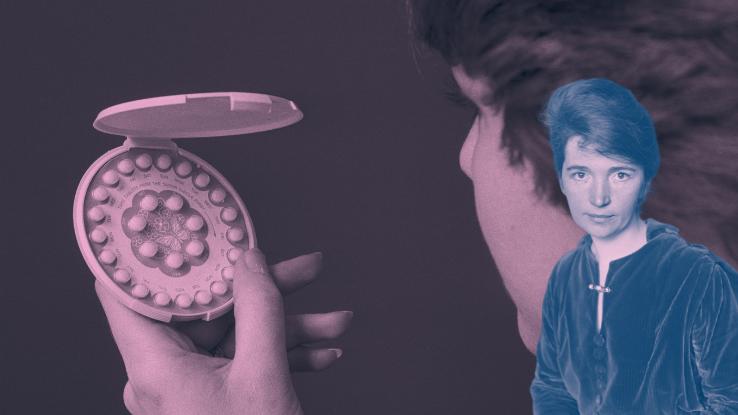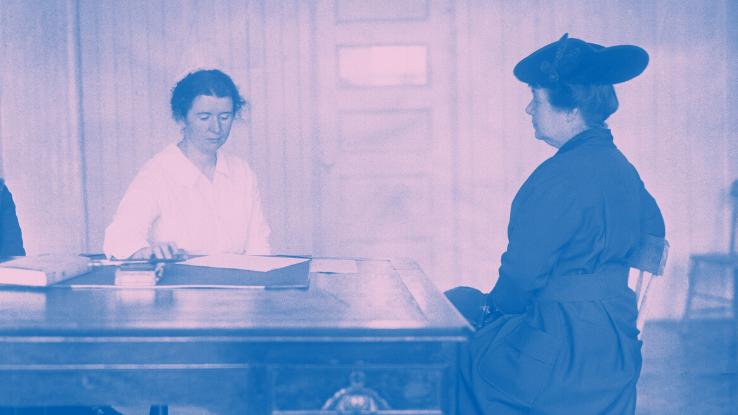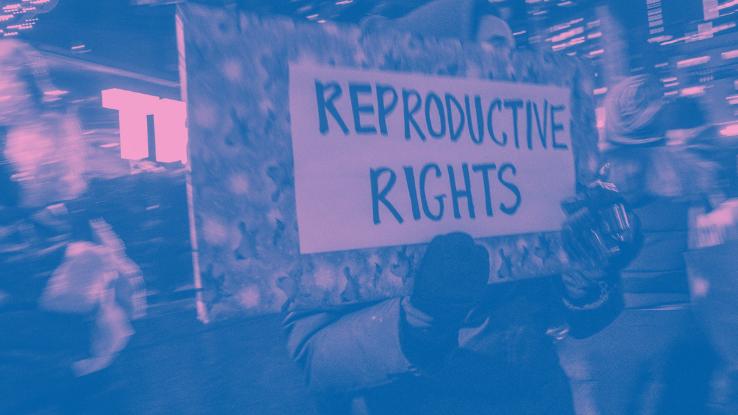How Long Does It Take To Get Your Period After Stopping Birth Control

Across many industries, colloquial terms for products and inventions have a real staying power. Yous've probably heard someone refer to a tissue by saying "Kleenex," for case. Similarly, folks use the brand name Band-aid as a stand up-in for referring to bandages.
Some other common colloquialism? Calling birth command pills simply "the pill." Taken orally, these hormonal contraceptives are synonymous with the term — even though many medications come in sheathing (or pill) form. Nonetheless, if you lot say "the pill," people beyond generations volition immediately know that you're referring to birth control.
Today, a person's contraceptive choices extend across the pill. But the history of the ubiquitous phrase — and the medication itself — figure so prominently into the history of reproductive rights, wellness intendance, sexual health, and bodily autonomy. With this in heed, let'southward delve into the history of nascence control in the The states, and how this history is still deeply tied into the fight for equal rights today.
What Is "The Pill"?
Past definition, nascency control is any activity or medication that help regulate when (and if) cisgender women, intersex people, and individuals assigned female at nascence will get pregnant. Although the pill might exist ane of the more than common forms of contraceptive medication, intrauterine devices, implants, condoms, diaphragms, and methods of tracking ovulation are all forms of nativity control.

Of course, the pill remains one of the more accessible, safe and effective methods of nascence control. Not to mention, the pill left an indelible marker on American lodge when the revolutionary medication was first introduced. Prior to the pill, nascency control methods were cumbersome and often unreliable. The pill, on the other hand, was unimposing, piece of cake to apply, and less intrusive. According to the AMA Journal of Ideals, the Nutrient & Drug Administration (FDA) approved the commencement oral contraceptive in 1960, and, within two years, ane.two million American women were using the pill.
And then, what's in this revolutionary medication? Essentially, the pill is an ingestible form of progestin and estrogen. These hormones mimic pregnancy and trick the trunk into initiating all of the processes that brand it more hard to go pregnant. For example, more fungus forms on the walls of the cervix, which, in turn, prevents sperm from traveling up the birth canal, and the walls of the uterus become thinner. Nearly significantly, someone taking the pill volition stop ovulating, so there won't be any eggs to fertilize. Needless to say, the pill helped brand pregnancy more of a option than an inevitability, assuasive people to have a much larger caste of control over their reproductive health, bodies, sexual wellness, and futures.
History of Birth Command in the United States
In 1916, Margaret Sanger opened ane of the earliest-known birth command clinics in America. Due to the Comstock Act, which deemed birth control "obscene," the clinic could non write, publish, or distribute any information about birth control. Since virtually all methods of birth control were illegal at the fourth dimension, Sanger and her colleagues were also unable to perform or prescribe whatsoever methods of nativity control. Rather, the dispensary served as a source of information, allowing people — primarily women — to larn of safe and effectives ways of taking control of their reproductive health.

Decades afterwards opening her first clinic, Sanger met an endocrinologist, Gregory Pincus, who believed in her idea to develop a birth control pill. Testing the pill was maybe even harder than creating the pill; there was plenty of legal crimson record — non to mention an ingrained, societal (and misogynistic) fear surrounding the reproductive system and the sexual health of women. After receiving a generous donation from Katherine McCormick, a wealthy biologist and activist, Pincus and Sanger ran a larger clinical trial in Puerto Rico, where laws weren't as restrictive.
Eventually, the FDA approved the pill in 1957, merely it was only to be used in the treatment of menstrual disorders experienced by married women. In 1960, the FDA fully canonical nascency control as a contraceptive. Despite the expansion of the FDA approval, at that place were nevertheless millions of people who did non accept admission to nativity command. In 1965, the Supreme Court ruled that states were non allowed to ban nascency command pills, but it wasn't until 1972 that the Supreme Court ruled that unmarried women had the right to take nativity command pills. In many ways, referring to the medication as "the pill" was built-in out of a necessity — to be discreet and avoid any stigma.
In the early decades of the widespread use of oral contraceptives, doctors and patients who were reporting serious side effects, like blood clots and strokes, were ignored, and this led to a campaign against nascence control from the medical community. There was also a business concern surrounding where birth control pills were existence distributed. "Sanger's stated mission was to empower women to make their own reproductive choices," Time reports. "She did focus her efforts on minority communities, because that was where, due to poverty and limited access to health care, women were especially vulnerable to the effects of unplanned pregnancy." However, these efforts, and Sanger's legacy, have been tainted by her well-documented comments in support of eugenics, a now-discredited, discriminatory motion mired in white supremacist beliefs.
How Birth Control Relates to Equality
Using the pill is far less controversial today than it was in decades by, but nascency command — and other facets of reproductive freedom — continues to be met with opposition in the U.S. For instance, many conservative Christian sects object to nascence control, assertive that information technology goes against God'southward will. Politically, this has long been a stance that right-wing politicians and supporters have on as well, oft taking aim against Planned Parenthood, reproductive rights, access to abortion and contraception, and more.
Why? Because birth control relates to sexual wellness, these groups of people human activity equally though the pill is a matter of morality. That is, their religious or political beliefs can actually interfere with health care. Even now, religious and non-turn a profit employers can offer health insurance plans that exclude coverage of nascence control if done so because of a religious or moral conventionalities.
On the other mitt, the Affordable Intendance Act states that all health insurance plans offered in the Health Insurance Market must cover FDA-canonical methods of nativity control. That's just one footstep toward providing admission to reproductive wellness intendance. For example, birth control is one of the safest medications on the market today, but it can't be bought over the counter (OTC); many groups, such equally Costless the Pill, are fighting to brand OTC birth command a reality in the U.S.

Of form, others are hoping to make the pill complimentary of charge to further support gender equity and equality efforts — in addition to making the pill more than accessible to all people, regardless of socioeconomic class, race or gender. "Despite meaning strides in women'southward reproductive health, disparities in access and outcomes remain, specially for racial–ethnic minorities in the United states," a 2020 study reports. "Information suggest that the disproportionate risk for women of colour for reproductive wellness access and outcomes expand beyond private-level risks and include social and structural factors, such as fewer neighborhood health services, less insurance coverage, decreased access to educational and economical attainment, and even practitioner-level factors such as racial bias and stereotyping." Needless to say, the pill being free of charge — and more easily attainable — could go a long way in remedying these racial disparities.
People who support access to birth control — and fight for reproductive justice — understand that without nascence command women and other people at take a chance for pregnancy face up severe disadvantages across many facets of life. For one, an unplanned or unwanted pregnancy tin touch on one's ability to work or build a career. In other instances, someone who may get significant might non be physically, emotionally or mentally healthy plenty, or have access to the resources, to have and raise a kid safely. In fact, over 800 people die during pregnancy ever day; millions are saved from this fate due to nativity control access.
Access to contraception allows people to programme their lives by affording them more opportunity; that is, instead of being handed a decision, people can cull. The pill may exist tiny, but, undoubtedly, it gives millions of people a huge heave of support past allowing them to programme for parenthood if they want to embark on that path.

Resource Links:
- "History of Oral Contraception" via AMA Periodical of Ethics
- "Birth Control" via Clinical Methods: The History, Concrete, and Laboratory Examinations | U.S. National Library of Medicine
- "New Study Confirms What Many Have Long Believed to be True: Women Employ Contraception to Improve Achieve Their Life Goals" via Guttmacher Institute
- "5 Ways Family unit Planning Is Crucial to Gender Equality" via Global Citizen
- "Birth Control Benefits" via HealthCare.gov
- "History of Yaz" via Drug Police Center
- "What Margaret Sanger Really Said About Eugenics and Race" via Time
- "Contraception: traditional and religious attitudes" via NIH | National Library of Medicine
- "The Side Effects of the Pill" via WGBH, PBS/KQED
- Estelle T. Griswold et al. Appellants v. Country of Connecticut — Case Data via Legal Information Constitute | Cornell Law School, Cornell University
- "Katherine McCormick" (biographical data) via Iowa State University
- "Comstock Act of 1873 (1873)" via Middle Tennessee State University
- "First American Birth Control Dispensary (The Brownsville Clinic), 1916" via The Embryo Project | National Science Foundation, Arizona State University, Eye for Biology and Club, the Max Planck Constitute for the History of Science in Berlin, and the MBL WHOI Library
- "Nascency Command: The Pill" via Cleveland Dispensary
- "Birth Control Pill" via Planned Parenthood
- "One-half a century of the oral contraceptive pill" via CFP – MFC, The College of Family Physicians of Canada | U.S. National Library of Medicine
- Free the Pill | freethepill.org
- "Racial and Ethnic Disparities in Reproductive Health Services and Outcomes, 2020" via Obstetrics and Gynecology, Lippincott, Williams & Wilkins | U.S. National Library of Medicine
How Long Does It Take To Get Your Period After Stopping Birth Control,
Source: https://www.symptomfind.com/healthy-living/pill-birth-control-history?utm_content=params%3Ao%3D740013%26ad%3DdirN%26qo%3DserpIndex
Posted by: normannottles1954.blogspot.com



0 Response to "How Long Does It Take To Get Your Period After Stopping Birth Control"
Post a Comment